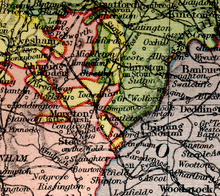Four Shire Stone
The Four Shire Stone is a boundary marker that marks the place where the four historic English counties of Warwickshire, Oxfordshire and Gloucestershire, and Worcestershire once met. Since 1931, with a change to the boundaries of Worcestershire, only three counties have met at the stone.
 The Four Shire Stone at the meeting point of Warwickshire, Oxfordshire and Gloucestershire, and formerly also Worcestershire | |
| Coordinates | 51°59′14.96″N 1°39′56.65″W |
|---|---|
| Material | Stonework |
| Height | 9 feet |
Boundary marker
The Four Shire Stone is not a single stone, but a nine-foot high monument, built from the local Cotswold stone. It is in the English midlands at the northern corner of a T junction on the A44 road, a mile and a half east of the small town of Moreton-in-Marsh, at 51°59′15″N 1°39′57″W, grid reference SP2301432023. The existing structure was probably built in the 18th century, and is a grade II listed building.[1] There was an earlier "4 Shire Stone" on or near the site in 1675.[2] Thomas Habington's Survey of Worcestershire mentions "the stone which toucheth four sheeres, a thing rarely scene".[3]

Five (formerly seven) civil parishes meet at the stone:[5]
- Moreton-in-Marsh to the west, in Gloucestershire;
- Formerly Batsford to the northwest, also in Gloucestershire, until Batsford/Moreton-in-Marsh boundary change in 1987;[6]
- Formerly Lower Lemington to the north, also in Gloucestershire, and which merged into Batsford in 1935;[7]
- Great Wolford to the north, in Warwickshire;
- Little Compton to the northeast, also in Warwickshire;
- Chastleton to the southeast, in Oxfordshire;
- Evenlode to the south, now also in Gloucestershire; until 1931 it was a detached part of Worcestershire.
Most of Worcestershire is to the north-west of the stone. Thus the order of the four counties around the stone was different from what one might expect from a map of England. The stone ceased to be the meeting-point of four shires in 1931, when Evenlode was transferred to Gloucestershire, so since that date only three counties meet at the stone.[8]
The J. R. R. Tolkien Society claims that the Four Shire Stone inspired the "Three-Farthing Stone" in J. R. R. Tolkien's book The Lord of the Rings. In that work, the The Shire, the homeland of the hobbits is divided into four farthings, three of which meet at the "Three-Farthing Stone".[9][10]
See also
- Quadripoint
- Three Shires Oak
References
- "Four Shire Stone, British Listed Buildings". Retrieved 8 May 2018.
- Ogilby, John (1675). Britannia Atlas. Richard Nicholson of Chester, map dealer. p. Plate 44. Retrieved 1 October 2013.
- Abingdon, Thomas (1897). "Evenlode". In Amphlett, John (ed.). A survey of Worcestershire. Vol.2 Pt.2. Oxford: James Parker for the Worcestershire Historical Society. p. 68.
- Because of an error in the printing, the salient of Oxfordshire that extends to the stone appears in mauve rather than the violet of the rest of Oxfordshire.
- "Gloucestershire". Ordnance Survey Miscellaneous Boundary Maps. Vision of Britain. 1967. Retrieved 3 May 2018.; "Oxfordshire". Ordnance Survey Miscellaneous Boundary Maps. Vision of Britain. 1966. Retrieved 3 May 2018.; "Warwickshire". Ordnance Survey Maps of England and Wales. Vision of Britain. 1900. Retrieved 3 May 2018.
- "The Cotswold (Parishes) Order 1986" (PDF).
- "Gloucestershire". Ordnance Survey Sanitary Districts, showing Civil Parishes. Vision of Britain. 1888. Retrieved 3 May 2018.; Elrington, C. R., ed. (1965). "Parishes: Lower Lemington". Gloucester. Victoria County History. 6. London: British History Online. pp. 216–220. Retrieved 4 May 2018.
- "The Four Shire Stone Moreton-in-Marsh". Retrieved 12 August 2013.
- "Moreton-in-Marsh Tourist Information and Travel Guide". cotswolds.info. Retrieved 12 August 2013.
- Hooker, Mark T. (2009). The Hobbitonian Anthology. Llyfrawr. p. 98-99. ISBN 978-1448617012.